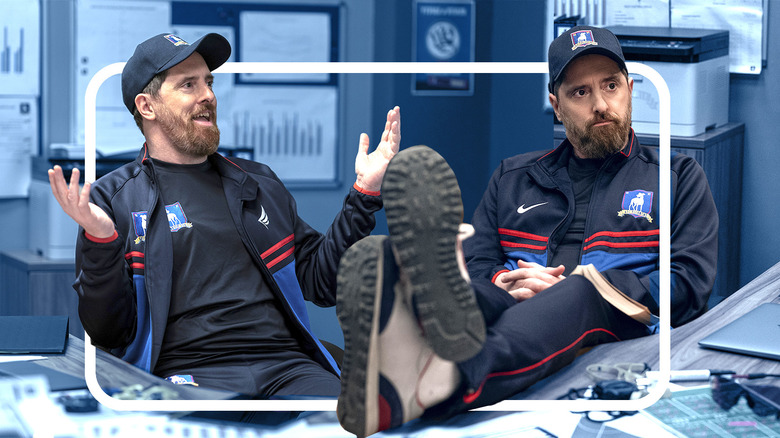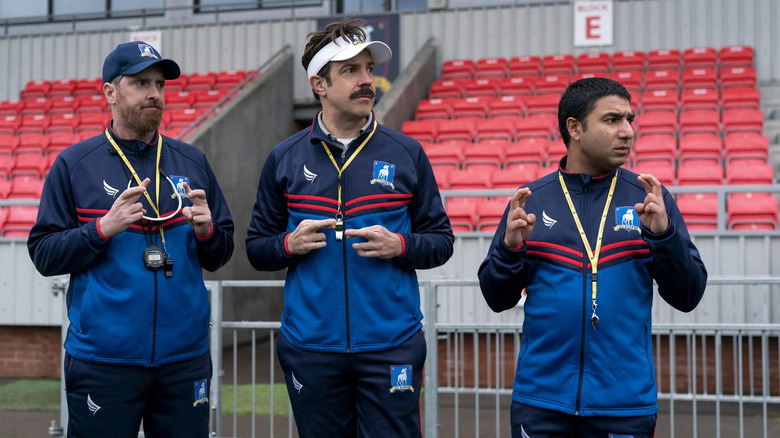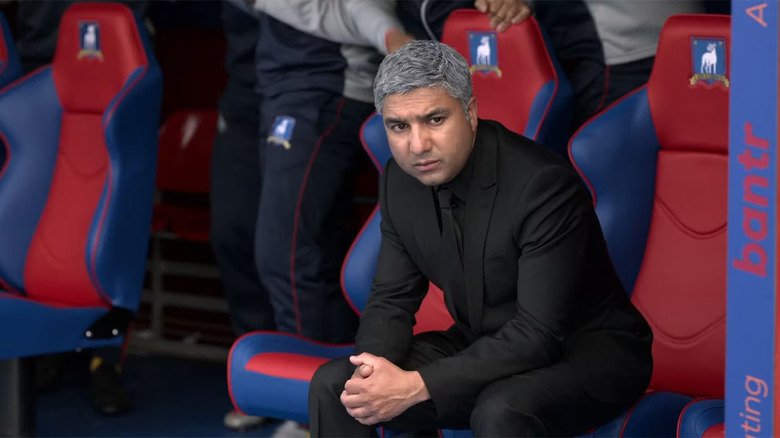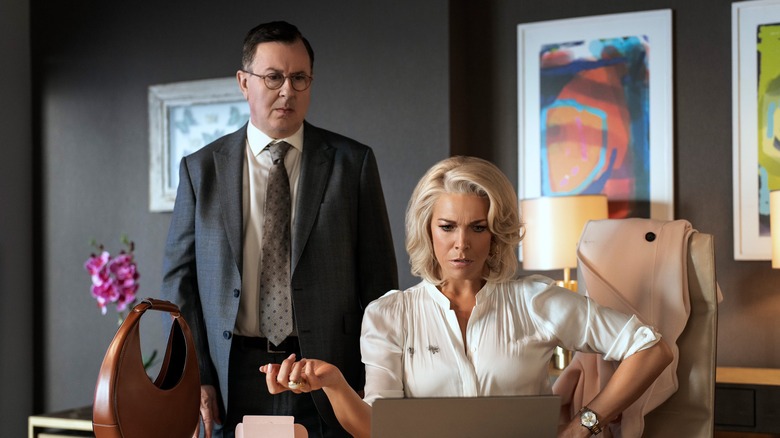Ted Lasso's Season 3 Premiere Has What Season 2's Premiere Lacked: A Sense Of Direction
If I had to compare season 2 of "Ted Lasso" to a season of any other show, it would probably be, strangely enough, season 2 of "Mr. Robot." Yes, these are two completely different shows; the latter's about a depressed hacker in a life-or-death mission to save the world from corporate supervillains, and the former's about a soccer team. But the conversation around "Ted Lasso" so far feels awfully similar to how people talked about "Mr. Robot" back before its third season first aired.
Both shows had successful debut seasons that blew audiences away despite the fact that its storylines were fairly predictable. If you've seen "Fight Club" before, you should've been able to tell where "Mr. Robot" was heading from its first episode; if you've seen a sports movie before, you shouldn't have been surprised when Ted won all the other characters to his side by the end of the first season. But initially, both shows' predictability was more of a strength. It can be fun to know where a show's going and to watch the exciting, satisfying ways its reaches that point.
But both shows dealt with severe backlash in its second seasons, and that was largely because its initial predictable structure was now gone. By season 2, "Mr. Robot" had gone past where "Fight Club" ended and was heading into uncharted territory. Meanwhile, the characters on "Ted Lasso" still had the long-term goal of winning it all in the premiere league, but they still had to spend an entire second season in relegation. In other words, their goal for all of season 2 was to return to where they started in season 1. It wasn't a huge surprise when the "Ted Lasso" season 2 premiere aired and the show felt, well, kind of aimless.
A season that took its sweet time
Maybe aimless is too harsh of a term, but season 2 of "Ted Lasso" was definitely a season that asked its viewers to be patient, to trust that the show knew what it was doing. The Richmond team would get its big victory some time next season, the show told us, but for now they were content to give us a string of low-stakes storylines where everybody's life seemed to be going fine. These were definitely hangout episodes, content to sit back and let the characters interact with each other. Fleshing out its characters and establishing a status quo are worthy goals, but for a lot of viewers, it felt like the show was dragging things out.
Season 2 of "Mr. Robot" still has a similar reputation, even though its pace clearly ramped up in its second half. The moment Elliot's storyline re-converged with the other storylines, "Mr. Robot" was back to season 1 levels of pacing, and it never slowed down again.
"Ted Lasso" season 2 also clearly showed a shift in pacing in its second half — not that it's gotten much credit for it, either. In its seventh episode, "Headspace," the show made it clear that Nate's cruel and insecure tendencies were not temporary side-effects of his growing confidence, but a serious, worsening problem. This ended up being the driving storyline of season 2, the thing that finally brought some serious conflict back into the show.
The importance of a good third season
The reason neither shows' season 2 initially got a ton of credit for picking up the pace as it went on was because there was no way of knowing season 3 wouldn't just slow things down yet again. If season 2 was slower than season 1, fans of both shows have seemed to reason, then season 3 would probably be even slower.
But when season 3 of "Mr. Robot" finally came — and blew everyone away — the slowness of its second season became acknowledged for what it was: a temporary shift in pacing designed to lay the groundwork for an explosive, climactic season 3. Although season 2 is still typically considered the show's weakest, most fans are happy to admit that the final seasons couldn't have been as good as they were without it. It's only once you can look back at the show as a whole that you can understand how necessary the sophomore season of "Mr. Robot" truly is.
Depending on how "Ted Lasso" season 3 turns out, season 2 of the show might be viewed the same way. If this new season hits it out of the park, season 2 will likely be viewed as (at worst) an effective middle chapter of a trilogy — one that deepened the characters and laid out the groundwork for a climactic final season. The new season's premiere, "Smells Like Mean Spirit," is certainly a promising start in that direction.
A season that knows exactly where it's going
The most refreshing part of the season 3 premiere is just how much conflict there is, and this time the conflicts have no easy answers. Keeley and Roy have broken up, Keeley's unhappy at her new job, Nate's still burning bridges with his old team, and Ted's not sure if he should still be doing any of this. Most interesting is the conflict between Rebecca and Ted. Driven to defeat Rupert more than anything, Rebecca's now angry at Ted for seemingly not doing enough to prepare the team for the upcoming season. It's a stark reversal from their dynamic in the first season, when Rebecca was rooting for Ted to fail, but it's also a nice change of pace from their static dynamic in season 2.
But the real driving force in this season is Nate and Rupert. With their Darth Vader/Palpatine dynamic (even down to the outfits and office aesthetics), these two have now firmly stepped into the proper villain roles this show has always needed. Much like season 1, "Ted Lasso" is back to a structure that any sports movie fan can recognize: we've got the underdog good team going up against the top dog bad team. There'll be a long road to the final match, but at least now audiences have a good idea of where the show's heading.
Just like the season 3 premiere of "Mr. Robot," "Smells Like Mean Spirit" has shown us that "Ted Lasso" has a clear endpoint in mind, and it's not wasting much time in getting there. The aimlessness of early 2 season wasn't necessarily a bad thing, but man does season 3's early approach feel like a breath of fresh air.



